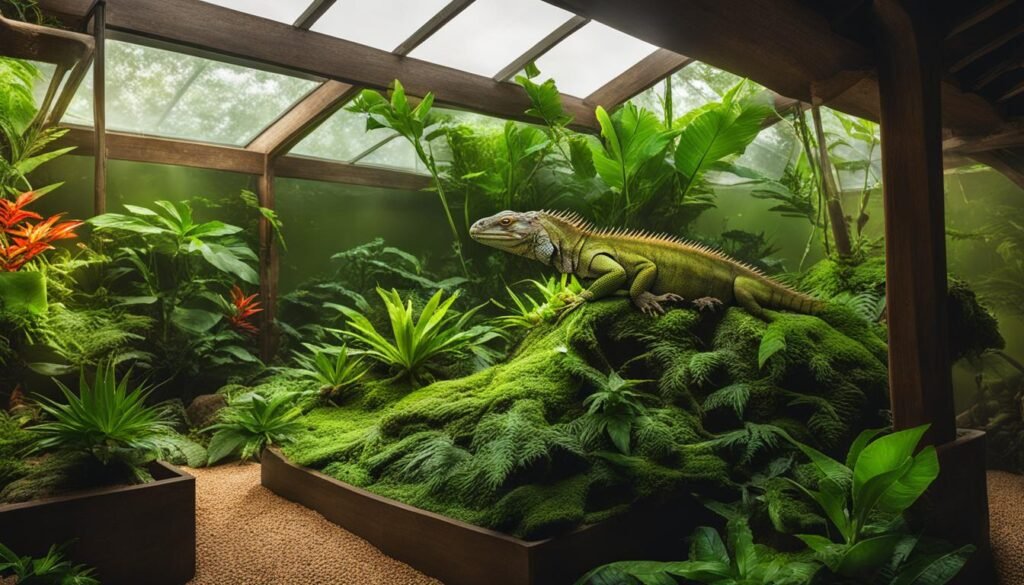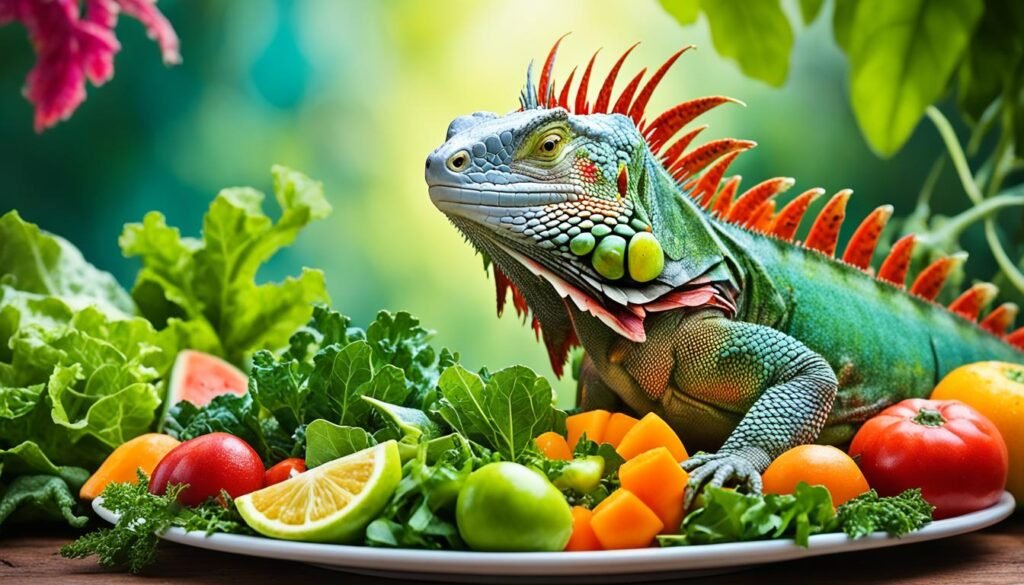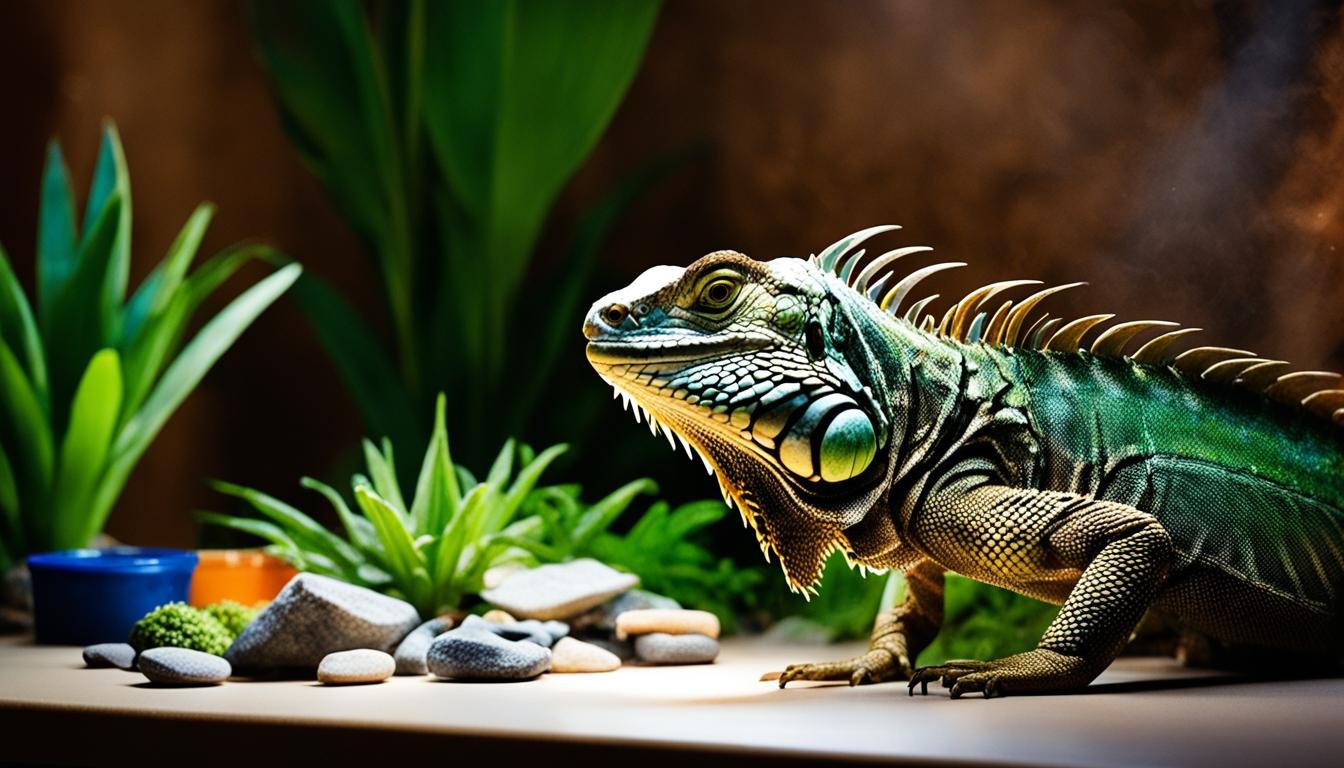Did you know that iguanas can live up to 20 years or more in captivity? These exotic pets require specific care to ensure their health and well-being. In this article, we will provide you with essential tips and tricks for caring for your iguana, including information on their diet, habitat requirements, and overall health. Whether you’re a new iguana owner or looking to improve your existing care routine, this comprehensive guide will help you provide the best possible care for your scaly friend.
Key Takeaways
- Proper iguana care is essential for their health and well-being.
- Iguanas can live for 20 years or more in captivity.
- Understanding their specific diet and habitat requirements is crucial.
- Maintaining the proper climate and providing enrichment are key.
- Regular veterinary care and handling techniques are important for their overall health and behavior.
Understanding Iguana Species and Behavior
Iguanas are fascinating reptiles that belong to various species. A few notable ones include the green iguana, rhinoceros iguana, and the Cuban rock iguana. Each species possesses distinct characteristics and care requirements, making it essential to understand their behavior to provide them with optimal care and ensure their well-being.
Green Iguana: The green iguana, scientifically known as Iguana iguana, is one of the most commonly kept iguana species as pets. They are native to Central and South America and are recognized for their vibrant green coloration, which helps them blend seamlessly with their arboreal habitat. Green iguanas are capable of growing up to 6 feet in length, and their diet mainly consists of leafy greens, fruits, and vegetables.
Rhinoceros Iguana: As the name suggests, the rhinoceros iguana (Cyclura cornuta) possesses a unique appearance. This species derives its name from the bony outgrowths on its snout, similar to the horns of a rhinoceros. Rhinoceros iguanas are native to the Caribbean and primarily inhabit rocky areas. They have a more limited diet compared to other iguana species, consisting of a variety of flowers, fruits, and leaves.
Cuban Rock Iguana: The Cuban rock iguana (Cyclura nubila), endemic to Cuba, is a robust and brilliantly colored reptile. Males of this species develop a crest of spines, enhancing their striking appearance. Their diet includes leafy greens, fruits, and flowers, with some individuals even consuming insects. Cuban rock iguanas are known for their calm and docile nature, making them popular pets for reptile enthusiasts.
Understanding the behavior and characteristics of your specific iguana species is crucial for providing appropriate care. Each species may have varied preferences when it comes to diet, habitat, and social interaction. By familiarizing yourself with your iguana’s species-specific needs, you can establish a nurturing environment and foster a healthy and happy bond with your scaly friend.
Creating the Perfect Iguana Habitat

Providing a suitable habitat is crucial for the health and happiness of your iguana. In this section, I will discuss the ideal size and materials for an iguana enclosure, as well as the importance of proper ventilation and enrichment.
Iguana Enclosure Size and Materials
When it comes to setting up an iguana enclosure, size matters. Iguanas require ample space to move around and exercise. A spacious enclosure allows them to climb, bask, and explore, mimicking their natural habitat. The minimum recommended size for an adult iguana enclosure is 8 feet long, 4 feet wide, and 6 feet high.
When selecting materials for your iguana enclosure, choose options that are safe, durable, and easy to clean. Avoid using cedar or pine as they can be toxic to reptiles. Instead, opt for materials like pvc, melamine, or glass. These materials are non-toxic and provide excellent insulation to maintain the proper temperature and humidity levels.
Proper Ventilation and Enrichment
Ventilation is essential for regulating air quality and preventing the buildup of harmful gases in the iguana enclosure. Ensure that the enclosure has vents or mesh panels that allow for adequate airflow. This helps maintain a healthy environment for your iguana.
Enrichment is vital to keep your iguana mentally stimulated and physically active. Provide various climbing structures, branches, and platforms within the enclosure to replicate their natural habitat. Adding foliage and hiding spots also gives your iguana a sense of security.
| Key Considerations for Iguana Enclosure: | |
|---|---|
| Size | An adult iguana enclosure should be at least 8 feet long, 4 feet wide, and 6 feet high. |
| Materials | Choose non-toxic materials such as pvc, melamine, or glass for the enclosure. |
| Ventilation | Ensure proper airflow through vents or mesh panels. |
| Enrichment | Provide climbing structures, branches, and hiding spots to keep your iguana active and stimulated. |
Maintaining the Proper Climate for Your Iguana
Iguanas are tropical reptiles and require specific temperature and humidity levels to thrive. Maintaining the proper climate is essential for the health and well-being of your pet. In this section, I will provide you with valuable information on setting up the right heat source, ensuring the correct temperature, and creating adequate humidity and lighting conditions for your iguana.
Iguana Temperature
The temperature inside your iguana’s enclosure plays a crucial role in regulating their metabolism and overall health. It is essential to provide a temperature gradient that allows your iguana to thermoregulate effectively. The basking area should be kept between 95°F (35°C) and 100°F (38°C) to replicate their natural habitat. The cooler side of the enclosure should range between 80°F (27°C) and 85°F (29°C). Monitoring the temperature with a reliable thermometer is highly recommended.
Iguana Heat Source
Creating a suitable heat source is vital to maintaining the correct temperature for your iguana. One of the most efficient heat sources is a ceramic heat emitter or a reptile-specific heat bulb. These heat sources emit infrared heat, which provides warmth without emitting visible light that may disrupt your iguana’s natural light cycle. Position the heat source above the basking area, ensuring it is securely attached and cannot fall or harm your pet.
Iguana Humidity
Iguanas require a moderately humid environment to support their respiratory health and prevent dehydration. The humidity level in the enclosure should be kept around 60% to 70%. To maintain adequate humidity, misting the enclosure with water once or twice a day is recommended. Additionally, you can include a humidity hide or provide a shallow water dish for your iguana to soak in, promoting hydration and regulating humidity levels naturally.
Iguana Lighting
Proper lighting is crucial for the well-being of your iguana as it helps regulate their circadian rhythm and supports vitamin D synthesis. UVB lighting is essential to prevent metabolic bone disease, a common ailment among reptiles. Use a high-quality UVB bulb specifically designed for reptiles, and ensure it covers at least two-thirds of the enclosure. Remember to replace the bulb regularly, as its UVB output diminishes over time.
Creating the right environment for your iguana’s specific climate needs is essential for their overall health and happiness. By carefully monitoring and maintaining the temperature, providing a suitable heat source, regulating humidity levels, and ensuring proper lighting, you can provide your iguana with the optimal climate they require.
| Climate Element | Optimal Range |
|---|---|
| Temperature (Basking Area) | 95°F (35°C) – 100°F (38°C) |
| Temperature (Cooler Side) | 80°F (27°C) – 85°F (29°C) |
| Heat Source | Ceramic heat emitter or reptile-specific heat bulb |
| Humidity | 60% – 70% |
| UVB Lighting | Cover at least two-thirds of the enclosure with a high-quality UVB bulb |
Feeding Your Iguana a Nutritious Diet

Iguanas are herbivores and their diet plays a crucial role in their overall health and well-being. Providing a balanced and nutritious diet is essential for your iguana’s growth and longevity. Here, I will discuss the importance of a proper iguana diet, recommended food choices, and a feeding schedule to ensure your pet receives the essential nutrients it needs.
The Importance of a Balanced Diet
Just like humans, iguanas require a variety of nutrients to stay healthy. A balanced diet for your iguana should consist of a mix of fresh fruits, vegetables, and leafy greens. This ensures they receive the necessary vitamins, minerals, and fiber for optimal nutrition.
Recommended Food Choices
When it comes to choosing iguana food, opt for organic produce whenever possible to avoid pesticides and chemicals. Some recommended fruits for your iguana include:
- Mangoes
- Papayas
- Strawberries
- Blueberries
- Apples
Vegetables and leafy greens are also essential for your iguana’s diet. Good choices include:
- Kale
- Collard greens
- Mustard greens
- Bell peppers
- Squash
Remember to wash all fruits and vegetables thoroughly before serving to remove any potential contaminants.
Feeding Schedule
Establishing a regular feeding schedule is important for your iguana’s digestion and overall routine. Aim to feed your iguana once or twice a day, offering a variety of fruits and vegetables during each meal. Observe your iguana’s eating habits to determine the appropriate portion sizes and adjust as needed to maintain a healthy weight.
| Time | Meal |
|---|---|
| Morning | A mix of fruits and leafy greens |
| Afternoon | A variety of vegetables and herbs |
Additionally, provide your iguana with fresh, clean water at all times. Avoid offering high-sugar or processed foods, as these can lead to health complications.
By following a balanced diet and establishing a consistent feeding schedule, you’ll provide your iguana with the nutrition it needs to thrive. Remember to monitor their weight, energy levels, and overall health to ensure they are receiving the proper nutrients. A well-fed iguana is a happy and healthy companion!
Understanding Iguana Health and Common Problems
Keeping your iguana’s health a top priority is essential for its long and happy life. Like any living creature, iguanas can experience common health problems that require careful attention and veterinary care. By understanding these issues and being proactive in their prevention and treatment, you can ensure the well-being of your beloved pet.
Common Iguana Health Problems
As an iguana owner, it is important to be aware of the following common health problems that can affect your reptilian friend:
- Respiratory Infections: Iguanas are susceptible to respiratory infections, which can be caused by environmental factors such as low humidity or drafts. Symptoms may include wheezing, nasal discharge, and difficulty breathing.
- Metabolic Bone Disease: This condition results from a lack of calcium, vitamin D, or proper UVB lighting in an iguana’s diet. It can lead to weak or deformed bones, muscle weakness, and tremors.
- Digestive Issues: Iguanas may experience digestive problems like impaction, constipation, or diarrhea. These issues can result from an improper diet, inadequate hydration, or intestinal parasites.
- Parasites: Internal and external parasites, such as mites, ticks, and worms, can infest iguanas, leading to various health complications.
- Thermal Burns: Improper basking areas or inadequate heat sources can expose iguanas to thermal burns, which can range from mild to severe depending on the duration and intensity of the heat exposure.
These are just a few examples of the common health problems that iguanas can face. It is crucial to monitor your pet’s behavior and physical condition regularly to detect any signs of illness or discomfort.
Signs of Iguana Illness
Recognizing the signs of illness in your iguana is vital for early intervention and appropriate care. Some common signs of illness to watch for include:
- Loss of appetite or sudden weight loss
- Lethargy or increased aggression
- Abnormal feces or changes in fecal patterns
- Swollen joints or difficulty moving
- Visible parasites on the skin or in the stool
- Labored breathing or wheezing
- Abnormal skin color or lesions
- Changes in behavior or activity level
If you notice any of these signs or any other concerning behaviors, it is crucial to consult with a reptile veterinarian experienced in iguana care as soon as possible.
Importance of Regular Veterinary Care
Veterinary care plays a critical role in maintaining the health and well-being of your iguana. Regular check-ups with a qualified reptile veterinarian can help identify and address potential health issues before they become serious. A veterinary examination may include a thorough physical examination, fecal analysis, bloodwork, and diagnostic imaging if necessary.
In addition to routine check-ups, it’s essential to follow your veterinarian’s advice on vaccinations, preventive treatments (such as parasite prevention), and dental care. Your reptile veterinarian can also provide guidance on proper nutrition, habitat maintenance, and any other specific care requirements for your iguana.
Remember, as an iguana owner, you play a crucial role in maintaining your pet’s health. By being attentive to your iguana’s behavior, providing a suitable environment, feeding a balanced diet, and seeking professional veterinary care, you can ensure a long and vibrant life for your scaly friend.
Handling and Taming Your Iguana
Properly handling and taming your iguana is essential for establishing a bond of trust and promoting positive behavior. Iguanas can be skittish or even aggressive if they feel threatened or uncomfortable. By following these tips, you can create a calm and secure environment for your iguana that encourages taming and minimizes stress.
1. Approach with Confidence and Respect
When approaching your iguana, it’s important to exude confidence and respect their personal space. Start by slowly and gently reaching out your hand without making sudden movements. Allow your iguana to sniff and investigate your hand to become familiar with your scent.
2. Supportive Handling Techniques
Always support your iguana’s body when handling them to make them feel secure. Use both hands to securely hold them, ensuring a gentle grip on their body. Avoid gripping their tail too tightly, as this can cause distress.
3. Gradual Introduction to Handling
Start with short handling sessions and gradually increase their duration as your iguana becomes more comfortable. Initially, limit handling sessions to a few minutes and gradually extend the duration over time.
During handling, monitor your iguana’s behavior closely. If they show signs of distress, such as thrashing their tail or hissing, gently return them to their enclosure and try again later.
4. Positive Reinforcement and Rewards
Use positive reinforcement techniques to reward good behavior and promote a trusting relationship. Offer your iguana small treats, such as their favorite leafy greens, after successful handling sessions. This helps to associate handling with positive experiences.
5. Minimize Stressful Situations
Avoid exposing your iguana to stressful situations that may hinder their taming progress. Limit loud noises, sudden movements, and the presence of other pets or unknown individuals during handling sessions.
| Taming Techniques | Benefits |
|---|---|
| Gentle Petting and Stroke | Promotes relaxation and bond-building |
| Slowly introducing hand-feeding | Develops trust and positive association with human interaction |
| Providing secure hiding spots | Gives the iguana a sense of safety during taming sessions |
With patience and consistency, you can successfully tame your iguana and develop a trusting relationship. However, it’s important to remember that every iguana is unique, and the taming process may take time. Be patient, and always prioritize your iguana’s well-being and comfort.
Iguana Safety and Maintenance Tips
Ensuring the safety and well-being of your iguana requires regular maintenance and attention. By following these simple tips, you can create a safe environment for your pet and maintain their habitat and essential heat sources.
Safety Precautions
- Always handle your iguana with care, supporting their body and avoiding sudden movements.
- Keep your iguana away from household hazards such as electrical cords, toxic plants, and open windows.
- Secure their enclosure or habitat to prevent escapes and potential injuries.
- Provide a sturdy and appropriate climbing structure to prevent falls.
Habitat Cleaning Tips
Maintaining a clean and hygienic habitat is vital for your iguana’s health. Here are some cleaning tips:
- Regularly remove any waste and soiled bedding from the enclosure.
- Spot clean the habitat daily, keeping an eye out for any signs of mold or fungal growth.
- Deep clean the enclosure at least once a month by emptying and disinfecting all surfaces.
- Use a reptile-safe cleaner or a mixture of water and vinegar to clean the enclosure.
Maintaining Heat Sources
Proper heat sources are crucial for maintaining the correct temperature gradient for your iguana. Here’s how to ensure your heat sources are functioning effectively:
- Regularly check the temperature within the habitat using a reliable thermometer.
- Ensure that the heat source, whether it’s a heat lamp or a heat mat, is positioned securely.
- Follow the manufacturer’s instructions for maintenance and replacement of heat bulbs or mats.
- Keep spare bulbs or mats on hand in case of emergencies.
By implementing these iguana safety and maintenance tips, you can create a safe and healthy environment for your beloved pet.
Conclusion
Caring for an iguana requires dedication and a deep understanding of their unique needs. By following the tips and tricks outlined in this article, you can provide the best possible care for your iguana and ensure their health and happiness.
Remember, creating the perfect iguana habitat is crucial. Providing a suitable enclosure with the right size, materials, and proper ventilation will contribute to their overall well-being. Maintaining the proper climate is also essential, ensuring the right temperature, humidity, and lighting levels for your iguana’s comfort.
Feeding your iguana a nutritious diet is vital for their health. As herbivores, they require a balanced variety of fruits and vegetables. Establishing a feeding schedule and offering recommended food choices will help meet their nutritional needs. Additionally, keeping an eye out for common health issues and seeking regular veterinary care will ensure your iguana stays healthy and happy.
Handling and taming your iguana requires patience and understanding. By implementing positive training techniques and reducing stress, you can build a strong bond with your iguana. Lastly, never forget to prioritize safety and maintenance. Regularly cleaning their habitat and maintaining heat sources will help create a safe environment for your beloved pet.


5 thoughts on “Caring for Your Iguana: Essential Tips & Tricks”